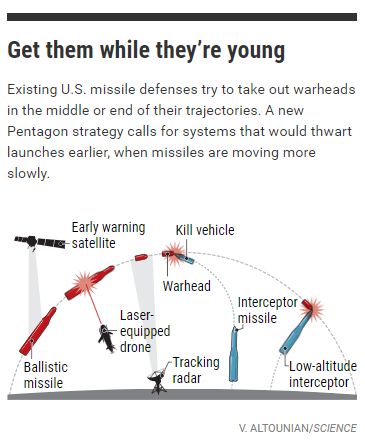Decades after Reagan’s ‘Star Wars,’ Trump Calls for Missile Defenses That Would Blast Warheads from the Sky
Nuclear warheads, rocketing across oceans in less than 30 minutes, would be tough to take down. Existing U.S. missile defenses aim to confront the warheads in space, in the middle of their ballistic trajectories, disabling them with a colliding interceptor launched from land or sea. Experts liken the challenge to hitting a bullet with a bullet. Even in controlled Department of Defense tests, success has been as chancy as a coin toss.
Now, President Donald Trump’s administration wants to lift those chances by putting sensors and interceptors in space, and by going after warheads during their boost phase, when they are rising more slowly and still attached to large and noticeably hot booster rockets. Last week, the Pentagon released its Missile Defense Review—its first strategy update since 2010. The plan would expand existing ground-based missile defenses, but also add sensor-laden satellites, laser-equipped drones, and missile-carrying fighter jets.
Many experts are critical of the proposed space and boost-phase technologies. Past studies found them to be infeasible or prohibitively costly. And there is little evidence that picture has changed, says Theodore Postol, professor emeritus of science, technology, and national security policy at the Massachusetts Institute of Technology in Cambridge. The new review “is a policy document in a vacuum relative to science and technology,” he says. He and other experts also worry that expanding U.S. missile defenses into new domains could spur nuclear powers such as Russia and China to more aggressively pursue advanced weapons that would be immune to the defenses, such as maneuverable, low-flying hypersonic cruise missiles.
The primary U.S. missile defense strategy is still deterrence, which aims to prevent adversaries from launching a nuclear strike by making it clear they would face an immediate and overwhelming U.S. nuclear response. But the military wants other options, and over the past few decades it has fielded ground-based systems designed to knock out missiles midtrajectory. The new review calls for bolstering these systems. For instance, the fleet of Aegis ships capable of launching interceptor missiles would expand from 38 to 60 by 2023. And the number of interceptors on land, initially built in Alaska and California to combat missiles from North Korea, would grow from 44 to 64.

The review also calls for placing defenses in space. It would start with a network of satellites with infrared sensors to detect the heat of launches and track missiles through their flight. A 2012 report from the U.S. National Academies of Sciences, Engineering, and Medicine (NASEM) in Washington, D.C., recommended against that idea, arguing it was too expensive and would not outperform an existing system that combines ground- and sea-based radars with a small number of infrared-detecting satellites. David Montague, former head of missile systems at Lockheed Martin and co-chair of the 2012 report committee, is discouraged to see the satellite concept persisting. “Every spring it shows up like a lotus blooming out of a trash barrel,” he says.
In its focus on boost-phase technologies, the review suggests a laser on board a drone or an aircraft could take out missiles. The idea has been studied before: In a 2010 Pentagon test, researchers destroyed a missile with a megawatt-class laser fired from a modified Boeing 747, but the laser had a range too short for practical use and required huge quantities of toxic chemicals. A new project is testing lighter solid-state fiber lasers on an aircraft, but such lasers max out at less than 100 kilowatts. Developing a laser powerful enough to take out a missile, yet compact enough to fit on a drone, would require orders-of-magnitude improvements, says Philip Coyle, a board member of the Washington, D.C.–based Center for Arms Control and Non-Proliferation and former laser scientist at Lawrence Livermore National Laboratory in California. “It’s like laser fusion—it’s always 40 years away.”
In addition to lasers, F-35 fighter jets could carry interceptor missiles, the review proposes. But experts say that for a jet to strike a rising ballistic missile, it would either need to be very close or carry a prohibitively heavy interceptor. Postol has proposed using missile-equipped drones around North Korea, because they could continuously patrol the airspace around the small peninsular country. But he admits the idea is “at the edge of what we think might be doable.”
Most controversially, the review endorses the option of creating a dense network of space-based interceptors that would not just detect, but also shoot down missiles. The idea dates to former President Ronald Reagan’s administration, when it was derided as “Star Wars.” Because such a system would require up to 2000 satellites in low-Earth orbit, it would cost hundreds of billions of dollars, the NASEM study found. It would also weaponize space and endanger existing space assets, says Laura Grego, a physicist and missile-defense expert at the Union of Concerned Scientists in Washington, D.C. However, the review calls for a study rather than a specific plan—a relief for Grego. “I think cooler heads prevailed, or wiser heads prevailed,” she says.
While unveiling the review at the Pentagon last week, Trump went beyond that cautious language, predicting that space-based interceptors would ultimately be a “very big part of our defense and, obviously, of our offense.”
Funding for any plan, however, needs lawmakers’ blessing. For fiscal year 2018, the Republican-controlled Congress boosted the budget of the Missile Defense Agency from $8.5 billion to $11.5 billion. But Democrats, who have been less bullish about antimissile systems, now control the House of Representatives. Grego predicts the administration’s plans “will face a lot more skepticism.”
Gabriel Popkin is a journalist based in the Washington, D.C., area.


Spread the word